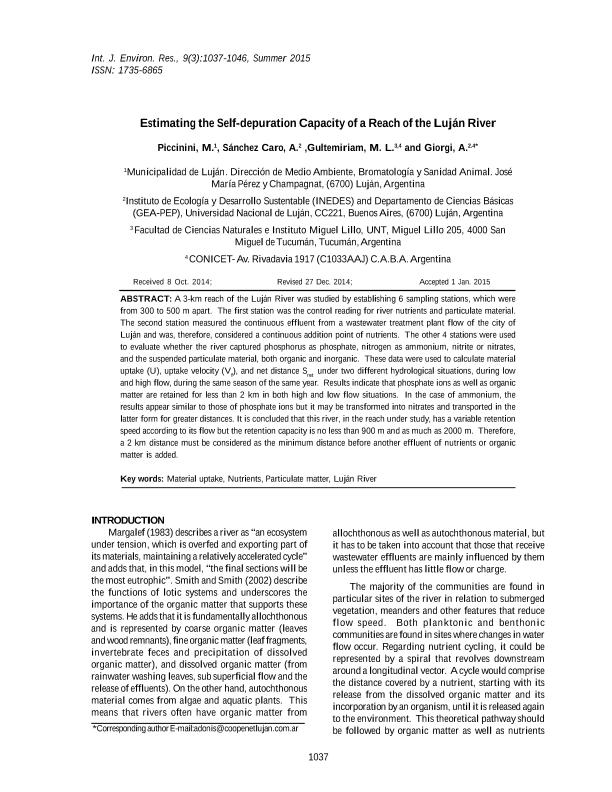Artículo
Estimating the Self-depuration Capacity of a Reach of the Luján River
Fecha de publicación:
08/2015
Editorial:
University of Tehran
Revista:
International Journal Of Environmental Research
ISSN:
1735-6865
Idioma:
Inglés
Tipo de recurso:
Artículo publicado
Clasificación temática:
Resumen
A 3-km reach of the Luján River was studied by establishing 6 sampling stations, which were from 300 to 500 m apart. The first station was the control reading for river nutrients and particulate material. The second station measured the continuous effluent from a wastewater treatment plant flow of the city of Luján and was, therefore, considered a continuous addition point of nutrients. The other 4 stations were used to evaluate whether the river captured phosphorus as phosphate, nitrogen as ammonium, nitrite or nitrates, and the suspended particulate material, both organic and inorganic. These data were used to calculate material uptake (U), uptake velocity (Vf), and net distance Snet under two different hydrological situations, during low and high flow, during the same season of the same year. Results indicate that phosphate ions as well as organic matter are retained for less than 2 km in both high and low flow situations. In the case of ammonium, the results appear similar to those of phosphate ions but it may be transformed into nitrates and transported in the latter form for greater distances. It is concluded that this river, in the reach under study, has a variable retention speed according to its flow but the retention capacity is no less than 900 m and as much as 2000 m. Therefore, a 2 km distance must be considered as the minimum distance before another effluent of nutrients or organic matter is added.
Palabras clave:
material uptake
,
nutrients
,
particulate matter
,
Lujan river
Archivos asociados
Licencia
Identificadores
Colecciones
Articulos(SEDE CENTRAL)
Articulos de SEDE CENTRAL
Articulos de SEDE CENTRAL
Citación
Piccinini, Mauricio; Sánchez Caro, Anibal; Gultermiriam, M.L.; Giorgi, Adonis David Nazareno; Estimating the Self-depuration Capacity of a Reach of the Luján River; University of Tehran; International Journal Of Environmental Research; 9; 3; 8-2015; 1037-1046
Compartir
Altmétricas




